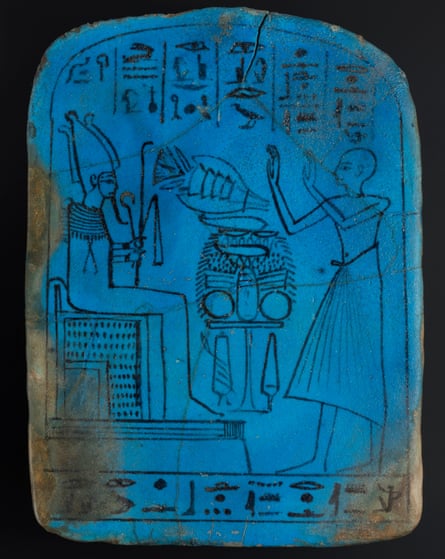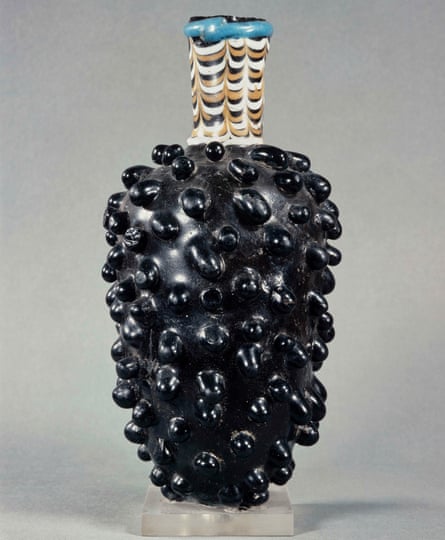Who knew there were famous artists in ancient Egypt with unique styles, depicting what they saw and felt? Well, most of the time there weren’t, although this exhibition does introduce you to one. From the Old Kingdom to the time of Cleopatra, the ancient Egyptians expected very much the same things of their artists, in a style that barely changed. An extraordinary limestone stela, or engraved slab, that was lent to the Fitzwilliam by the Louvre shows how young Egyptian artists were taught to see in the “correct” way, to make nature conform to the official style. A square grid demonstrates how to calculate proportions to render, for instance, a cat in a perfectly still profile, like a little feline god, an abstraction that was to be repeated for millennia.
Yet Made in Ancient Egypt strives to take you beyond the sublime formal facade to glimpse the artists or, as it calls them more cautiously, “makers” behind the golden coffin portraits and pharaohs’ statues. “Who built the seven gates of Thebes?” asked Bertolt Brecht in his poem A Worker Reads History. Here they are, the metalworkers, woodworkers, weavers. In a wooden model made about 4,000 years ago, female workers seated on the ground weave on a loom while others stand spinning thread. You can see a fine example of such women’s handiwork, a white dress made 4,500 years ago. It hangs up, spooky as hell.

But it was the one famous artistic genius here who held me most. A sculpted head of a girl in red quartzite, her eyes now empty almond-shaped holes, has a tiny face but a huge bald dome of a head, out of proportion with her delicate features. It comes from a period when Egypt’s cultural continuity was radically interrupted by the reign of Akhenaten from about 1353 to 1336BC. He revolutionised religion and encouraged artists to go wild, go real. The girl is probably one of his daughters, exuding eerie beauty. But there’s more. Found at Akhenaten’s capital Amarna, this masterpiece comes from a house near that of the star sculptor Thutmosis, whose home and workshop was discovered by German archaeologists in 1912. It has his style. He also created Egypt’s most famous work, the bust of Nefertiti. This anything but sensationalist exhibition leaves you to deduce that the two are probably by the same artist: the ancient Egyptian Leonardo.
But this was a world in which art was too important to be sold and auctioned, exhibited and criticised. It was part of a religion dedicated to life after death and most ancient Egyptian art comes from tombs, where it had magical purposes. Even here, individual creators made their mark – often literally. In a frieze between two gods, an artist has scratched a now illegible name. Another maker has left a handprint beneath a clay “soul house”, a home for the dead.
Documents hint at working conditions, which weren’t too bad. Ancient Egypt seems not to have been the oppressive slave-society stereotypes suggest. On this evidence, it was a land of skilled craftspeople who could make demands on employers. A record of work absences from the royal tombs in the Valley of the Kings, inscribed on limestone almost 4,000 years ago, records the entire workforce taking two days off for a colleague’s funeral. You imagine it was a beer-fuelled sendoff.

These skilled people – “hemut” – could be so successful they got fancy funerals, the aspiration of all ancient Egyptians, and put up monuments that record not just individuals but their families, for talents such as working with bronze, which were passed down, just like craft skills would be around the world for millennia to come.
A block-like model here shows artists how a sphinx should be made, but ultimately this fascinating quest for the hands that carved the Great Sphinx is quixotic. There is an ineffable mystery to ancient Egypt. Where it succeeds is in making you look at Egyptian art beyond the magic and mythology to admire the sheer skill: wooden chairs with animal-feet legs, a glass bottle in the form of a bunch of grapes, an exquisite copy of the Book of the Dead. You marvel at the precision, passion and playfulness of ancient Egypt’s creators.
Every artist leaves an autobiography, in their dedication and flamboyance, even in the skills passed on through Egypt’s history, which came together in this culture’s great collective work – the commemoration and preservation of the dead. The wooden board that lay over the mummy of a man who died 3,000 years ago resembles a spaceship designed to take him to the stars. On the inside, there’s a gold painting of a solar boat in which he might journey through the sky. This is art for eternal life’s sake. But it is also art that preserves the name of a worker, for the deceased is Nespawershefyt who had risen to be an overseer of craftsmen at a temple. His team saw him off in style, with a golden visage as fine as a pharaoh’s.
“The books are filled with names of kings,” complained Brecht’s history-reading worker. But Nespawershefyt’s name survives through art.

 2 months ago
70
2 months ago
70

















































